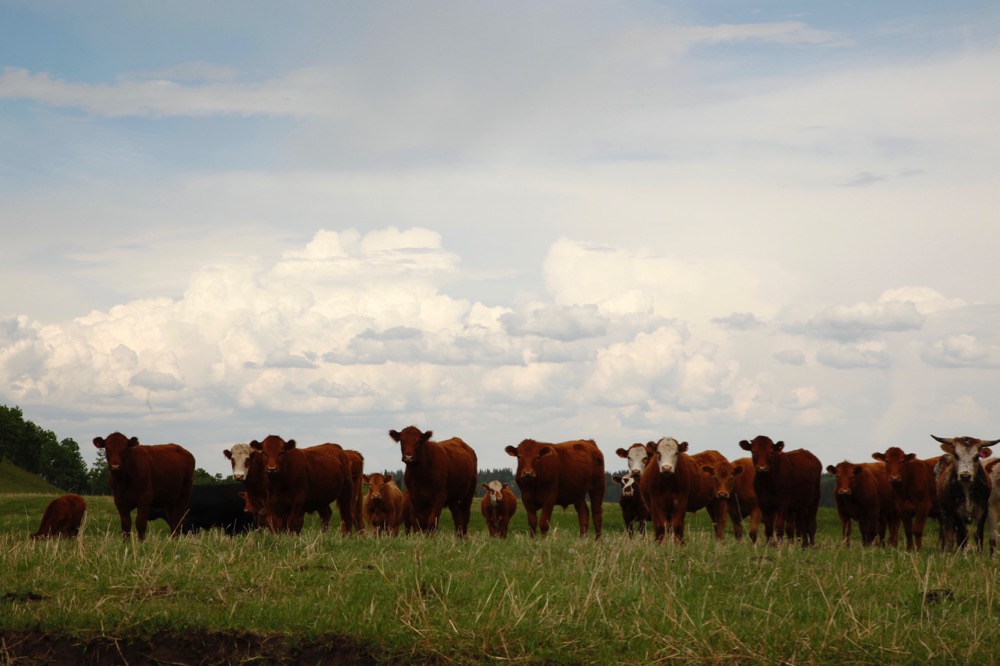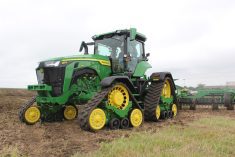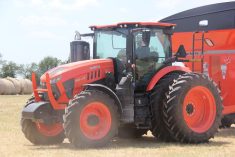Hang on to your cowboy hat, or maybe it should be your mass spectrometer — a team of researchers working through the University of Saskatchewan has just received about $6.75 million to launch a major project, using technology at the molecular level which should help Canadian beef producers produce more efficient and productive animals.

Dr. Gregg Adams a veterinary reproductive biologist with the U of S is leading the multiyear or ongoing project called the IntegrOmes Project — that name captures the terms “integrated omics”, but more on that later. Adams is leading a team that involves about 10 researchers from across the country working on the project centered at the U of S Livestock and Forage Centre of Excellence (LFCE).
It is a complex research project, but in pretty simple terms researchers hope to collect and analyze mega data from the genetics, gut activity, metabolism and behaviour of thousands of cattle, boil all that down to predictive traits and genetic markers— so for the cow-calf producer it means they should be able to have the analysis of a hair sample from a calf give them a pretty solid description of how that animal will perform.
Read Also
Some perspectives of what’s in store for 2022
By Lee Hart Between COVID-19, supply-chain disruptions and now the conflict in the Ukraine it seems like any calm or…
Purebred operators for example, could analyze a hair sample from a newborn bull calf and almost immediately know its production strengths and weaknesses — its genetic potential — without having to wait until the animal reaches puberty. It is information and analysis that will greatly strengthen EPDs.
“It could help us identify genetic traits that might explain why some animals are susceptible to a disease and others aren’t,” says Adams. It might also help them identify specific animals, or even breed genetics that do well on coarser feeds such as browsing on brush. That could also be a valuable management tool.
And it is possible that much of this analysis and/or diagnosis could one day be done on a device that fits into the palm of your hand.
On another level, Adams says the research could improve the diagnostic capabilities of veterinarians. “A veterinarian is called to the farm to investigate a sick animal,” he explains. “So hopefully through this research we will have the diagnostic tools so that on the first call, the first afternoon, in the first two hours that veterinarian will be able to analyze a blood sample or hair follicle and make a diagnosis almost immediately.”
Adams thinks back to a case of bovine tuberculosis a few years ago in Alberta where it took two years and about $40 million dollars to figure out the extent of the disease spread — six head in one herd — and in the meantime it put 30,000 animals on 140 different farms on hold in quarantine. And they never did figure out the source. He also pointed to bison in Wood Buffalo National Park that are a natural reservoir of bovine tuberculosis and brucellosis. Rather than just cull animals that wander out of the park, Adams says this rapid testing technology could be used to quickly test domestic cattle suspected of being exposed to bison. As a conservation measure the technology could be used to identify bison that are disease free. And ultimately the technology and improved testing could even help protect humans from contracting these zoonotic diseases.
“If we can put these tools in the hands of diagnosticians or farmers themselves, they can report the results immediately—within hours or a day rather than having to wait days or even weeks—then we can cut the head off an epidemic, or certainly focus on appropriate antibiotics,” says Adams.
It sounds like the list of the potential benefits where this research and technology could be applied is limited only by imagination. “This project has been two years in the making, and it’s created a lot of enthusiasm and momentum,” says Adams. “Once the infrastructure and equipment are in place and we become proficient in its use, the impact will be felt for a generation or more.”
HERE’S WHERE OMICS COMES FROM

“USask has an amazing facility and program centred around the Livestock and Forage Centre of Excellence, and expertise in all areas of livestock production, but one thing that has been missing is a genomic component,” says Adams in the official news release.
Genomics and other omics tools in biological science—such as phenomics, microbiomics, proteomics—involve the study of the appearance, structure and behaviour of animals, their microbiomes and cell proteins. Researchers have made tremendous progress in these areas over the past decade, and they can now use these advanced tools for extensive livestock production, he says.
Adams says a livestock reproduction specialist like himself, along with nutrition specialists and disease scientists all know where they need to focus research, but none of them are omics specialists. So now for the first time this project will bring together scientists like himself along with omics expertise and “reams and reams of data” that has never before been analyzed to provide answers or links to answers concerning livestock genetics and production.
By bringing together experts in microbiology, epidemiology, reproductive biology and forage nutrition, says Adams, the project aims to integrate the advances in omics tools to address challenges in the beef industry such as disease management, fertility improvement and environmental impact mitigation—something already in place in the dairy, hog and poultry industries.
The IntegreOmes Project was kicked off with $6.75 million in funding from the Canada Foundation of Innovation, and that is expected to attract another $10.1 million from institutional partners, private industry and vendor in-kind support.
With a group of scientists chomping at the bit to get started on this work, part of the money will be used to upgrade facilities in existing U of S labs, to install a high performance computer system that can handle data analysis, as well as fibre optics so researchers on the main campus and also at the U of S Goodale Research and Teaching Farm can communicate and network. The project will also see a new barn with some sophisticated livestock reproduction and cattle handling facilities built at the Goodale farm. It is an 840-hectare research farm, along with its pastures, cropland and hay fields, supports more than 230 head of beef cattle and specialized livestock year round.
USask researchers on the IntegrOmes project include: Cheryl Waldner, Janet Hill, Dinesh Dadarwal and Jaswant Singh, all from the Western College of Veterinary Medicine, and Matthew Links from the College of Agriculture and Bioresources. Other team members are Gabriela Mastromonaco (Toronto Zoo); Jocelyn Poissant (University of Calgary); Graham Plastow (University of Alberta); and Muhammad Anzar (Agriculture and Agri-Food Canada).
Adams says he might be slightly optimistic, but he’s hoping by the end of 2021 or early into 2022 — even before the paint is dry — the Canadian beef industry could start to see some of the first tools developed by the IntegrOmes Project.
Lee Hart is editor of Cattleman’s Corner based in Calgary. Contact him at 403-592-1964 or by email at [email protected]
DEFINITION OF OMICS
The branches of science known informally as omics are various disciplines in biology whose names end in the suffix -omics, such as genomics, proteomics, metabolomics, metagenomics and transcriptomics. Omics aims at the collective characterization and quantification of pools of biological molecules that translate into the structure, function, and dynamics of an organism or organisms.
Geonomics – mapping complete DNA
Genomics studies the structure, function, evolution and mapping of the complete DNA and the genetic makeup of animals. It deals with the complete set of genes and genetic material found in a cell or organism. Genomic technologies draw both producer interest and research investment in the beef industry.
Phenomics — genetics and how they are affected by on-farm management, environmental factors.
Selection emphasis is shifting away from traits related to animal productivity toward those related to efficient resource utilization and improved health and welfare/resilience. The goal of phenomics is to provide information for making decisions related to on-farm management, as well as genetic improvement.
Microbiomics – study of microbes in the gut
study of gut microbes? One of the stomachs, called a rumen acts as a fermentation vat where microbes break down the fibre. It is also these microbes that produces methane, which gets burped out during digestion (this process is called rumination).
Proteomics – study of proteins, methabolic pathways – what affects feed efficiency.
Based on the results obtained with the proteomic approach, in both differential expression and co-expression network analyzes, we are able to suggest the main metabolic pathways related to feed efficiency in the liver of beef cattle as: the microbial load from the gut; the biosynthesis of fatty acids, amino acids and …
Proteomics is the large-scale study of proteomes. A proteome is a set of proteins produced in an organism, system, or biological context. We may refer to, for instance, the proteome of a species (for example, Homo sapiens) or an organ (for example, the liver).
















